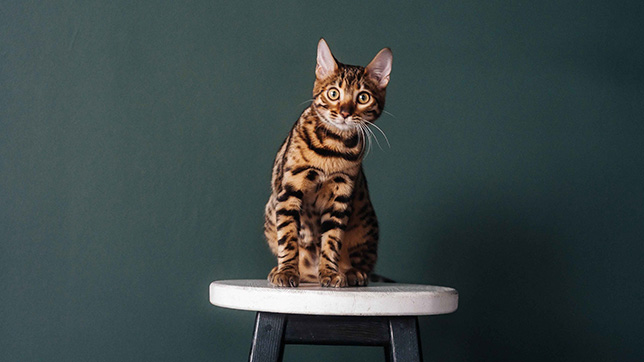28th October 2021
Bengal cats
Height
16 inches (to shoulder)
Weight
Males and Females 3.6lb – 15lb
Lifespan
9- 15 years

History
The Bengal cat has a unique heritage with an interesting story. They were originally bred with the domestic cat in the late 1980s by a paediatrician in an attempt to transfer feline leukaemia to the cat from a leopard.
However, the resistance to the form of cat cancer was not successful. Their breeding was then taken on by a professional cat breeder and in 1983, the Bengal cat was a recognised breed. They were first imported to England in 1991.
It has been said that the Bengal was also designed to deter people who wanted to keep wild cats as a pet.
Appearance
As their name suggests, the Bengal breed is wild-looking and has a distinct similarity to their leopard cousins, and the markings on their coat include large spots and rosettes as well as a white belly.
Bengals are often mistaken for the Tabby coat pattern but instead of a random organisation, a Bengal has horizontal stripes across their bodies. Some forms of the breed have what is called a “glitter gene”; something that gives the fur an iridescent glow. However, this is rare.
They have striking bright blue or green eyes with horizontal black stripes under their eyes, known as “mascara” markings.
They have a large, muscular build with strong hind-legs, along with a thick tail that is carried low to the ground; which is a trait they share with the leopard cat.
Temperament
Bengals are extremely playful and intelligent. This makes them easy to house-train, despite their mischievous behaviour when not given enough attention.
Along with being alert and curious, Bengal cats have an outgoing personality. They’re friendly and loveable, as well as energetic.
They’re loyal and will quickly become a key family member in your household.
Things to watch out for
Unless they have been socialised from a young age, Bengal cats tend to become aggressive towards other cats. This is why interaction with other animals is essential from a young age, and you should always check with the breeder to ensure that the Bengal has been in contact with other felines.
The Bengal breed has a strong hunting instinct, so expect them to run around your house and attack your feet! For this reason, they may not be suitable pets for homes with young children.
Is a Bengal cat for me?
If you’re looking for a chatty cat that loves exercising and being entertained, the Bengal could be the perfect cat for your home!
Did you know?
Due to their heritage, Bengal cats still have a natural love for water. So, keep your toilet seats closed when not occupied and expect them to love drinking from the tap!
To avoid unexpected costs when it comes to your Bengal’s health, consider protecting them with cat insurance.
Looking for more cat advice?
We’ve written some handy cat advice guides, to help you unlock the secrets of your mysterious moggy.
Need cat insurance?
Cat insurance can help cover the cost of veterinary treatment if your cat gets injured or falls ill.
We know pets
Our pets are part of the family. To achieve our vision of a better future for pets everywhere, we work with our partners, vets, and other veterinary professionals who are pioneering the latest advancements in animal care. Our campaigns, articles, and events are crafted to support, educate, and celebrate pet owners, while our policies are designed to provide peace of mind at an affordable price.
Yet our policies don’t just protect against the unexpected – they have purpose, too.
Since we were founded over 25 years ago, we've provided industry-leading policies that protect the nation’s pets, while also making a difference to animal welfare and our planet. Thanks to you, our policyholders, we've donated over £9 million to more than 830 animal welfare charities and conservancies, helping to support vulnerable pets and wildlife around the world.
We’re proud to be wildly different. Are you?
